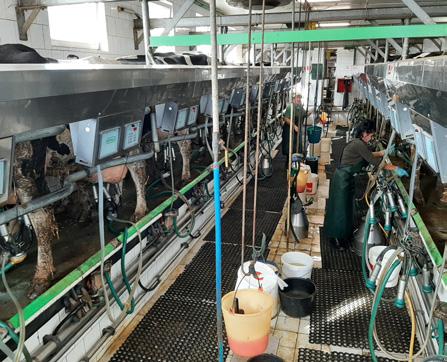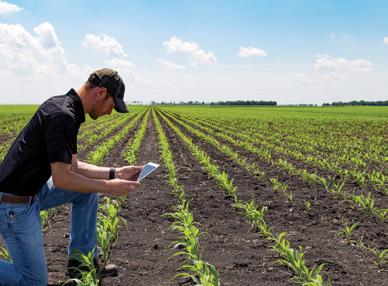
3 minute read
MILK QUALITY IN CROATIA
Herd acknowledged for top production credits genetics and herd management practices for its success
By Chris McCullough
A COMBINATION OF GENETICS AND CHANGES IN HERD MANAGEMENT have boosted production and milk quality at Farma Salas dairy farm in Marijanci, Croatia.
Through a strict set of breeding goals, the farm has achieved the status of top production herd in the country, awarded by Hapih, the Croatian Agency for Agriculture and Food.
Today, the herd is home to 450 cows and is concentrated on breeding for higher quality milk.
Farm manager Berislav Vulic, who is also a veterinarian, says the decision to start a dairy farm was a big one. Previously, the farm was focused on producing crops.
“Without any prior knowledge or experience, a milking parlour with a main barn was built and 330 Holstein Friesian pregnant heifers were imported from the Netherlands,” Vulic recalls of the dairy farm’s start. “Today, we have 450 cows plus an additional 450 heifers and calves as followers. On a number of occasions, we have surplus heifers to sell.”
The cows are milked twice per day, yielding 35 litres of milk each. The herd has progressed so well that last year it finished as the best farm in Croatia in terms of production, with 10,795 kg average milk yield at 4.6 per cent butterfat and 3.5 per cent protein.

These are notable gains because productivity per cow in Croatia is significantly below the EU average, according to a World Bank report.
The main milking herd is split into high and low production groups, and are housed separately to be fed different rations.

“The first lactation cows are always separated from the older cows,” Vulic says. “Each group has an external exercise area, and the dry cows and heifers have access to grazing areas, but due to the recent drought they have actually been receiving a full TMR ration.”
The farm employs 28 staff, including two vets. Cows are milked twice per day in a 12/24 Westfalia herringbone parlour.
With what he calls “sound advice” from his genetics supplier, Vulic follows a successful breeding strategy.

“We inseminate heifers and first-lactation cows with Holstein Friesian X-Vik sexed semen for the first two or three inseminations. On the older cows we use Belgian Blue semen,” he adds. “The goal is to achieve a balanced cow with the highest possible Nordic Total Merit index.”
Croatian Dairy Industry At A Glance
The Croatian dairy sector was hit by the 2008 global economic crisis, the abolition of dairy quotas and Russia’s embargo on food imports from the EU. The dairy subsector and the milk market have yet to recover from these triple blows, says a report from the World Bank.
• A record-low 102,000 dairy cows as of December 2021 (Eurostat).
• Croatia’s self-sufficiency in dairy, beef and pork is relatively low and has been decreasing with competition from other EU countries.
• The number of dairy farms dropped more than 50% from 2007 to 2018.
• More than 70% of Croatia’s milk production is concentrated in three large dairy processing companies.
• Two breeds (Simmental and Holstein-Friesian) account for 85% of the total national herd .
• Per capita milk consumption has dropped 18% , with consumers shifting toward processed dairy products.
Source: The Croatian Livestock Sector in the Perspective of the New CAP, 2021-2027, The World Bank, February 2021
Source: Lactanet
The index includes all economically important traits (such as yield, growth and fertility) for the Nordic red breeds of dairy cattle, plus Holstein and Jersey in Denmark, Finland and Sweden. It is the most complete total merit index in the world with 90 different sub-indices combined into 15 main traits. The purpose is to develop the cattle’s genetic capital to achieve higher profitability and functionality of the herd by breeding new generations with higher milk production and resistance to disease, for example.
Like every other dairy farm in the world, Farma Salas is experiencing higher feed costs, which eats into profit margins.
The TMR for the cows consists of crops grown mainly on the farm. These include hay, straw, haylage, silage, triticale, corn, and toasted soybeans. Additional soybean meal is bought from other companies, along with sunflower meal, molasses, vitamins, and minerals.
Ingredients are mixed together on the farm to make the concentrate, which is then mixed with other feeds in the mixer wagon.
“Currently, the biggest problem on the farm is the price of feed,” Vulic says.

“We are trying hard to be more efficient when feeding to save costs. This is done by using ration formulation software for all the groups.
“In the future we would like to build our own beef fattening unit, but as far as the number of dairy cows is concerned, we will not expand any further.”
Since employing the genetics strategy and advice, Vulic says the herd’s milk composition has improved. Other herd management changes have also helped boost herd health.
“Since using genetics we have improved our butterfat composition during the last three years by 0.3 per cent. Of course, this can also be improved with progress in feeding and long-term selection of bulls that are positive for percentage fat in milk,” he adds.





